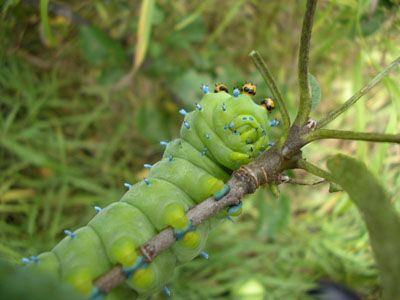
A Cecropia caterpillar, munching away on the leaves of this small and much beleaguered tree. I recognized the caterpillar right away because last year my neighbour Nancy called me to report one of these very striking critters down at her place (see Night Flyers).
Apple trees do not breed true. This little tree, like every other McIntosh, is grown from a cutting from another McIntosh grafted onto rootstock, eventually tracing back to the original tree discovered by John McIntosh in 1811 near Prescott, Ontario. I've never liked McIntosh apples, it's Gala for me. The McIntosh's slightly winey smell reminds me of the wet-wool-apple-and-peanut-butter smell of the cloakroom in primary school. But I do respect the history of the tree, and its instantiation in the yard here is beloved. Why "beleaguered"? In spite of love and respect this little tree was almost destroyed by a weed whacker two years ago. Luckily the destruction was above the graft, leaving enough of the McIntosh to regrow. It doesn't need the further setback of being devoured by a giant caterpillar. It was already looking pretty sparse when I found the Cecropia, so the caterpillar had to go.
Not only is this an impressive caterpillar, but it gives rise to a very beautiful moth, also know as the Robin Moth. Cindy of Woodsong has a very beautiful photo of the Cecropia moth here. So when I say "go," I mean it must move to another host plant.
This critter's got serious feet, and sharp spines. I know that some caterpillars' spines sting, and I couldn't remember if that was the case here, so gingerly, not wanting to crush it, and not wanting to get stung, I managed to disengage it from the tree. Turned out that the spines pricked but did not sting, but still I didn't want to carry it in my bare hands, so I popped it into a little planter for transport. There is a mature, generic apple tree in the yard, lots of leaves, one little caterpillar would be no threat, especially one so close to maturity, so I took it over there. I chose the apple tree because at the time I didn't know how particular this creature was about its host plant--turns out that it would probably have been content with any of a number of species. According to this site it is especially fond of Manitoba maple leaves, of which we have plenty.

Once it stuck itself to the bottom of this pot there was no chance of getting it out so I put the container in a crotch of the tree and left it alone.

I went back to check later and found the caterpillar munching happily in its new home.

It stayed on the tree for the next few days, then disappeared. Like many other moths and butterflies, these guys move off the host plant to make their cocoons, so my hope is that this is what happened here.








5 comments:
What a bruiser!
Once again I'm jealous! What a cool caterpillar. And...
1) Macs are my favourite commercial apple, although when I lived down south I much prefered the garden varieties
2) I haven't heard the term "cloakroom" in a dogs age.
Clare, I don't think I've heard "cloakroom" in a while either (i.e., since the sixties). We're of the same generation I think: not quite old enough to have actually worn winter cloaks, yet old enough to have put our coats in the cloakroom in primary school. Where do kids put their coats these days?
What a great sequence with this most baroque-looking caterpillar!
Great insect.
And glad to know there are others out there who relocate certain insects.
I did so with a couple of lynx spiders a few seasons ago. Our neighbors were most distressed by the large lynxes, and would have sprayed them with bug spray if I didn't move them.
Thanks, Lori. Always good to meet another critter relocator. And to hear about a bug spray use averted!
Post a Comment